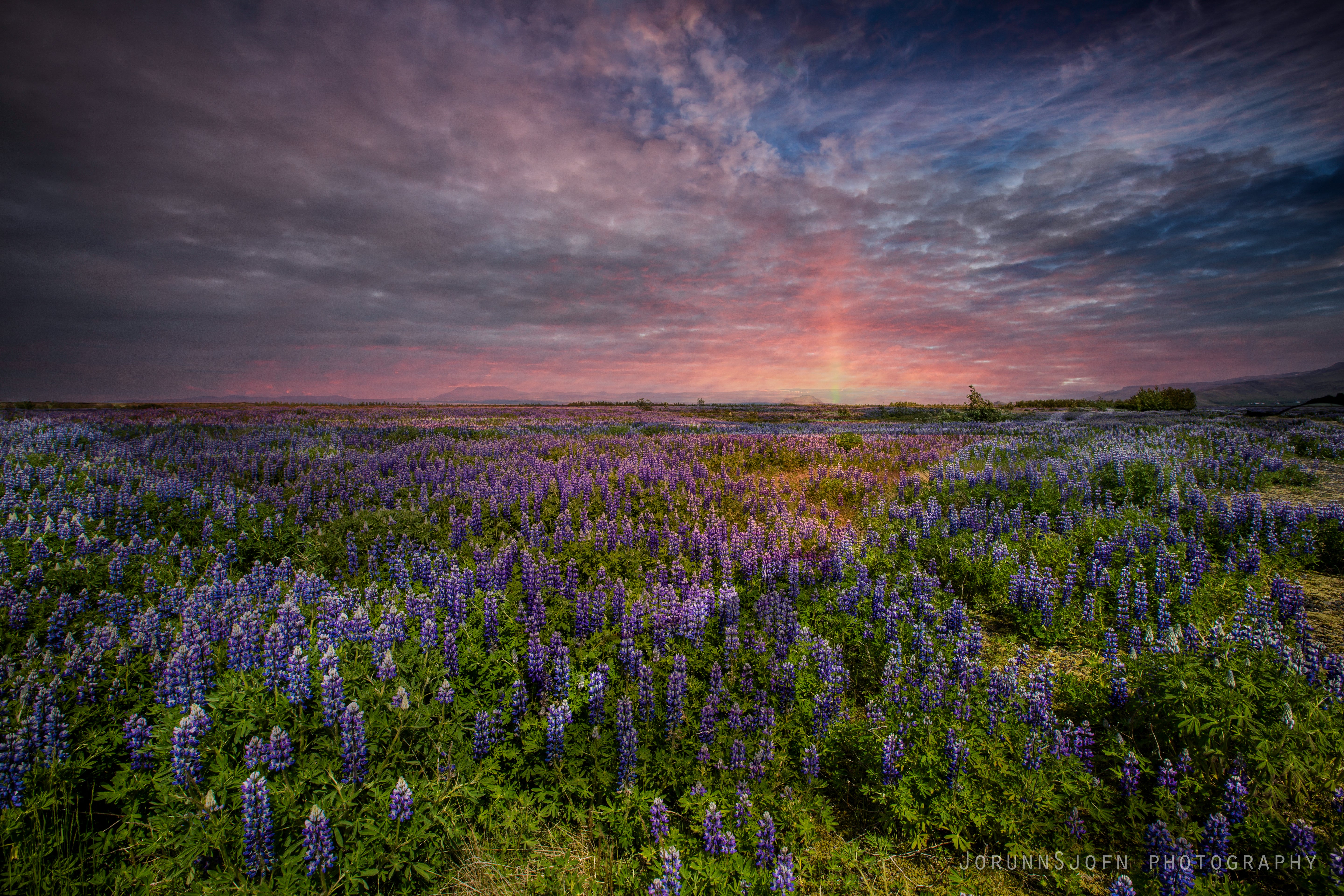
In my last travel-blogs, I have been showing you what beautiful treasures Bárðardalur valley has to offer. Now I am going to show you the next valley west of Bárðardalur, the forested Fnjóskadalur valley.
Here you will find a beautiful arched bridge, a cute Petting Zoo, and 3 churches.
To visit Fnjóskadalur valley you turn on road 833. A new tunnel has been built here; the 7.5 km long Vaðlaheiðargöng tunnel, and ring road 1 now leads through this tunnel instead of the Víkurskarð mountain pass.
Opening photo: Fnjóskárbrú bridge

Vaðlaheiðargöng tunnel in 2015
It can be quite dangerous to pass through Víkurskarð in blizzards in the wintertime, and it can even be impassable. V
íkurskarð was the second most travelled mountain pass in Iceland and ambulances had to pass through it.
So you can imagine what a great addition to the Icelandic road system the new tunnel will prove to be.

The tunnel was opened on the 21st of December 2018, and I first drove through it in May 2019. In the photo above you can see what the tunnel looks like from Eyjafjörður.
In the summertime I find Víkurskarð mountain pass to be a beautiful route with great scenery, so I will continue driving on that route. I will tell you a little more about the tunnel in the last part of this travel-blog.
The old boarding school at Skógar
The old boarding school at Skógar
Now let's first turn onto road 833 and see what the almost 30 km long Fnjóskadalur valley has got to offer. You will notice a red-painted building on your right-hand side, right next to the mouth of the tunnel.
This is the old school at Skógar, which operated from 1932-1972 as a boarding school, with the same teacher teaching all these 40 years!
Cafés have been open at the old boarding school. I hope there will be a café there for years to come, there is something so cozy about being able to stop here for coffee :)

Inside the old boarding school at Skógar
Before the tunnel was built archaeological examinations had to take place at Skógar so that no Viking things buried in the ground would be destroyed. The thing with the Vikings is that they were here so long ago that their stuff is buried in the ground and it is almost by chance that we have discovered some of their old stuff.
Some of it has been found above ground, like the Viking sword to the right in my photo below, which the farmer Einar Einarsson at Skógar found.
The Viking sword at Skógar
The Viking sword to the right was found at Skógar in Fnjóskadalur. It dates back to 1300-1400 Sarpur
A single-edged Viking sword made of iron was found here at Skógar in Fnjóskadalur, most likely from the 14th century. It is 84.5 cm long and 4 cm thick and was found above ground by the farmer at Skógar, Einar Einarsson. It was donated to the Archaeological Association in 1905.
The other Viking sword in my photo was also found above ground by Skjaldbreiður. Both these Viking swords are on display at Þjóðminjasafn Íslands - the National Museum of Iceland.
See also: A Compilation of the Viking Ruins & Pagan Burial Mounds I have visited on my Travels around Iceland
The arched stone bridge
Fnjóskárbrú bridge
Opposite Skógar you will find an interesting arched stone bridge, called Fnjóskárbrú bridge. It was designed by the only working engineer back then in Iceland, Jón Þorláksson, and built by the Danes in 1908.
The bridge was built for horses, livestock, and carriages and was back then the longest arch bridge in the Nordic countries, 55 metres. A new bridge was built across Fnjóská in 1968 and in 1993, when yet another bridge was built, this old bridge was closed for car traffic.
The bridge, which had been in use for 85 years, was rebuilt in 1993 by the Icelandic Public Roads Administration and serves as a monument of fine craftsmanship in the olden days. You can cross it on foot or horseback today.
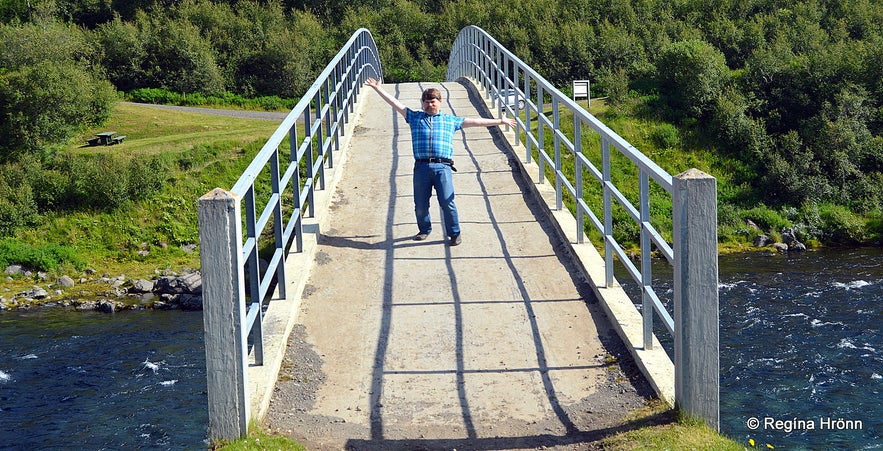
My husband walking on the arched Fnjóskárbrú bridge
The reason for building an arched stone bridge over the Fnjóská river and not a more traditional bridge is the depth of the river and its changeability.
Also, back then, there were hardly any roads in Iceland, and building material for bridges had to be imported. An arched bridge needs less steel and cement than the more conventional bridges.
But as fate has it sometimes when dealing with Icelandic nature, during the construction of the river an unparalleled flood caused the half-built arch to collapse into the river.
We drove across the bridge from 1968 to visit the old arched bridge.

Fnjóská river
Fnjóská river is the longest spring-fed river in Iceland, a beautiful blue river, some 117 km long. Salmon, sea char, brown trout, and regional char can be found in the river, which is a popular angling river.
The river originates in Sprengisandur in the highland of Iceland and runs into Eyjafjörður fjord, Iceland's longest fjord, through Dalsmynni further northwest.
See also: Eyjafjörður Fjord - Akureyri, the Capital City of North Iceland + 7 more travel-blogs about Eyjafjörður
Vaglaskógur forest
Vaglaskógur forest
Vaglaskógur forest in Fnjóskadalur is one of Iceland's largest and most popular forests to visit. It covers an area of some 300 ha and sports some of the tallest birch trees in the country.
In fact, Vaglaskógur is one part of the largest continuous forest in Iceland, which goes by different names depending on the land it belongs to.
Vaglaskógur is visited by thousands of travellers each year and here you will find good camping and picnic areas.
I have fond childhood memories from family picnics in Vaglaskógur and the name of this beautiful forest always warms my heart :)
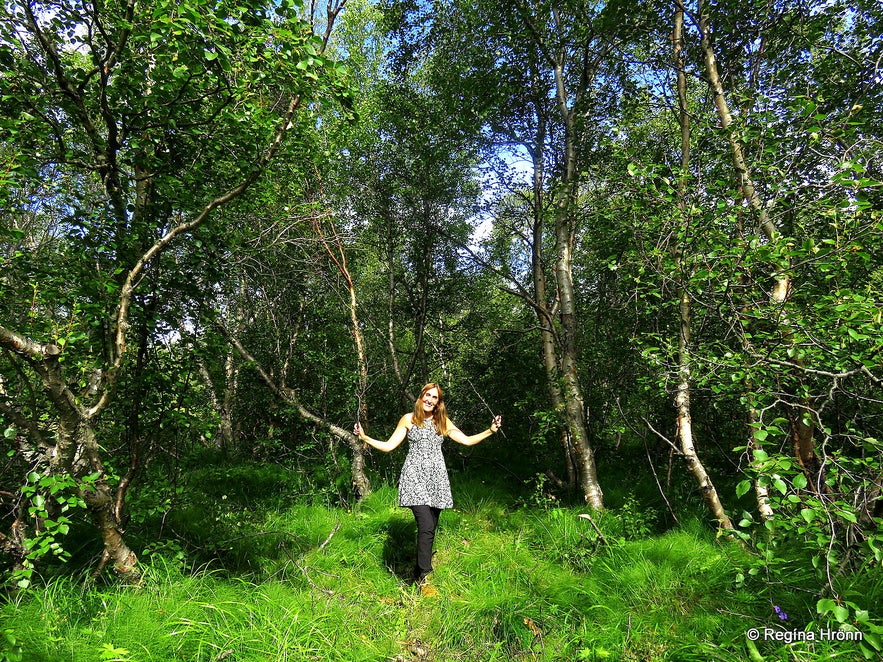
In Vaglaskógur forest, reconstructing a childhood photo of mine in the forest ;)
The Icelandic term, fnjóskur, refers to the trees in this fertile valley and means a dry twig.
The old name of the valley is Hnjóskadalur, but hnjóskur means tuber, as far as I know.
One of Iceland's poets, Kristján frá Djúpalæk (1916-1994), wrote a beautiful poem about lovers in Vaglaskógur forest, Vor í Vaglaskógi - Spring in Vaglaskógur forest, which we Icelanders like to sing at gatherings.
I adore Kaleo's version of it, so I add it here for you to listen to.
It is not the first version of the song, as it was first recorded back in 1966, by a famous Icelandic band, and sung by our beloved Vilhjálmur Vilhjálmsson.
That is the version I have listened to my whole life, and I like it a lot, but Kaleo's version just melts my heart.
Daladýrð Petting Zoo
A kid at Daladýrð
Passing through Fnjóskadalur valley we stopped at a Petting Zoo. I had heard of a new Petting Zoo in the valley and was eager to visit. It is called Daladýrð Petting Zoo, run by the farmers Birna and Guðbergur at Brúnagerði farm.
At the Petting Zoo, you can visit the farm animals of Iceland, plus a few other animal species, which the Vikings didn't bring with them to Iceland.
The Icelandic farm animals are Viking animals, as it were, and have kept their characteristics due to the isolation of Iceland. At Daladýrð you will also be able to meet the only native animal to Iceland, which was here before the Vikings arrived - the Arctic Fox. It wasn't around when I visited.

The little kids are so friendly and cuddly :)
At the Petting Zoo, we visited goats and pigs, cats and kittens, hens, and rabbits. And of course the Icelandic sheep and horses. I was thrilled to find one leader wether at the zoo, but leader wethers are a unique breed of Icelandic sheep that behave more like dogs than the average sheep.
They are the leaders of the herd and have a unique ability to predict weather changes and find their way even in a blinding snowstorm. They are lean and have long legs and a distinctive temperament.
I have read so many stories about their heroic deeds and to me, they are true heroes, which I highly respect :)
See also: the Study Centre on Leader-sheep in North-East Iceland - the Unique Breed of Icelandic Sheep

A leader wether and a ram at Daladýrð
The leader wether is the one to the left in my photo above. The ram next to it is also quite fierce-looking, so I thought it was the leader wether. I tried in vain to get their attention.
Birna tried to push the leader wether to get it to stand on its feet, so we could see its long legs, but it didn't budge ;) Ask Birna to tell you about the leader wethers when you visit the Petting Zoo, as they are unique to Iceland.
I saw several pigs at the Petting Zoo, but many locations in Iceland are named after pigs. The Icelandic term for a pig is svín. We have got Svínavatn - Lake of Pigs, Svínadalur - the Valley of Pigs, Svínafell - Pigs Mountain, etc.

Pigs at Daladýrð
The horses were fenced in outside. You will see the Icelandic horses in many places in the countryside; they are not ponies, but sturdy horses, who change into their winter coat when it starts getting colder.
I spotted these two beautiful foals by the road. They belong to the Petting Zoo.
Kids love visiting the Petting Zoo, and so do I, and I think the Petting Zoo at Daladýrð is a great addition to things to do in Fnjóskadalur. And I like the name Daladýrð - the Splendour of the Valley :)

Aren't they precious <3
Birna, who apart from being a farmer and running Daladýrð Petting Zoo, is a teacher and a textile designer.
She showed us how she creates beautiful patterns in the wool, which resonate with the Northern Lights, glaciers, lava, and snow. It was quite interesting watching her create the patterns.
You can visit her open textile studio Gjóska and see her work. There is a small store at the Petting Zoo, and the main Gjóska store is located on Skólavörðustígur street in 101 Reykjavík.

Birna creating patterns at her textile studio
The name, Gjóska, means volcanic ash and stems from the volcanic eruption in Eyjafjallajökull back in 2010.
The volcanic eruption had such a profound effect on Birna and gave her such inspiration, that she started creating these unique patterns.
You can see the lava flow pattern in my photo below, which I took at the studio.

The final product
I looked at the label and on it is written "Really made in Iceland", which I found a bit funny and telling, as so much stuff is imported from China these days.
But at least you know that you get the real deal, i.e. made by a local farmer, at Gjóska.
Illugastaðakirkja church in Fnjóskadalur
Illugastaðakirkja church
Next, we visited Illugastaðir, which was an old manor and is now a holiday resort. I visit all the churches on my travels in Iceland and found 3 churches in Fnjóskadalur. One of the churches is hidden away at Illugastaðir.
There has been a church at Illugastaðir since at least 1318, so this is an old church site, probably from the 11th century. The current church dates back to 1860.
Unfortunately, I was unable to get the key to any of them as it was the round-up season.
I love visiting Þjóðminjasafnið - the National Museum in Reykjavík and search for objects there, which belonged to the old churches and show them to you in their original location in my travel-blogs.

This old church bell, which I found at the National Museum, has the date 1600
This especially applies to this travel-blog of mine as I was unable to enter any of the 3 churches in Fnjóskadalur. I found an old church bell dating back to 1600, which was once in Illugastaðakirkja church, on display at Þjóðminjasafn Íslands - the National Museum.
Opposite Illugastaðir we saw another pretty bridge over Fnjóská river. As you can see from the photo below then we visited Fnjóskadalur in late August and the trees were withering and sporting an orange, yellow colour.
The green photos are from our visit in mid-August 3 years earlier, and there was quite a difference in the colours of the vegetation in the valley.
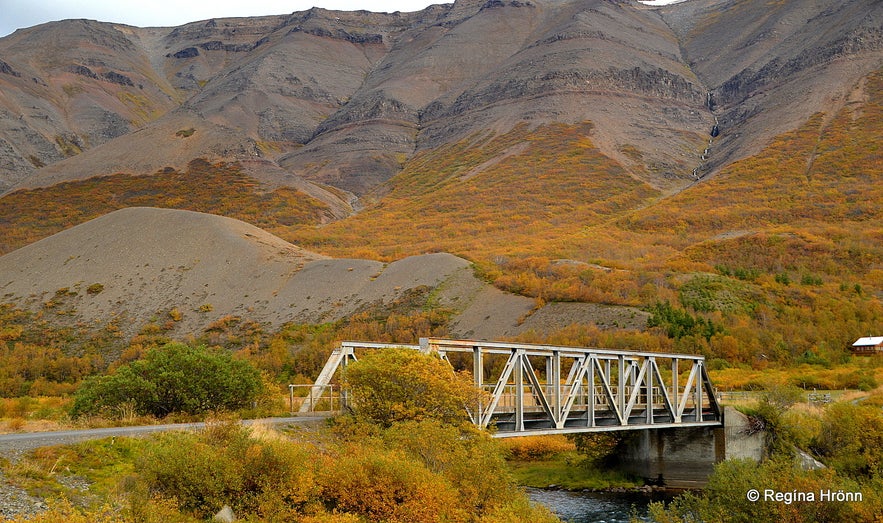
A bridge in Fnjóskadalur
We carried on and drove as far as we could into the valley and passed the harnessed geothermal area. The last farm is called Reykir, but farms by this name always have heat in the ground.
Reykir refers to smoke or steam, as in the name Reykjavík, the capital city of Iceland.
My cousin's wife grew up in Reykir. She had an encounter with an elf in the valley when she was a young girl. As you might already know if you have read my travel-blog, then Icelandic folklore is filled with stories about encounters with the elves of Iceland.
See also:
An Elf Woman catches a Ride across Skjálfandafljót River in Bárðardalur - Icelandic Folklore
The Sheriff's Wife at Burstarfell and the Elf-Rock in East Iceland - Icelandic Folklore

My husband by ruins in the valley
By Reykir the valley branches into three valleys: Timburvalladalur, Hjaltadalur, and Bleiksmýrardalur valley. We drove into Bleiksmýrardalur and followed the Fnjóská river.
On our way, we came across the ruins of earlier human habitation; turf house ruins. We stopped and checked them out.
The turf ruins in Fnjóskadalur are most likely Reykjasel or Kárasel. The Icelandic term "sel" means shieling, where some of the sheep were kept in the summertime.
When I posted this photo above on Facebook a friend of mine told me that by other turf ruins called Siggutóftir, the inhabitants in the valley started seeing a faint light in the ruins. When they went to check it out they saw it was Will-o'-the-wisp or Atmospheric ghost light, so in that case, it wasn't a ghost or of elf origin.

The turf outhouse at Steinkirkja farm
I check out all turf houses and ruins of turf houses on my travels in Iceland and have written a list of all the turf houses I have stopped by on my travels in Iceland with a myriad of photos of various turf houses around Iceland.
I found a turf outhouse at Steinkirkja farm on my way back through Fnjóskadalur and got permission from the farmers to take some photos of it for my collection.
On our way into Bleiksmýrardalur valley, we drove through a forest; deep in the forest we saw a myriad of logs on both sides of the road and passed a logger fast asleep in his car. 
Logging in Fnjóskadalur
We most likely startled him as I gather that not too many travellers drive through this area. Logging is practiced in Vaglaskógur and the valleys, seeing that it is such a large forest, for Iceland anyway ;)
The origin of the Fnjóská river is in Bleiksmýrardrög in Sprengisandur, but we didn't go this far, as we were on our way to Mývatn and had to go back. But we love driving into valleys to see what we will find. And I hope you enjoy exploring Iceland with me :)
See also: The amazing Mývatn & Krafla Area in North Iceland - a Compilation of the wonderful Sights
The polar bear sighting
I didn't see any polar bears, but I saw many trolls in the landscape further in the valley, which looked quite dramatic.
I found an account about a polar bear sighting in Þjóðsögur Jóns Árnasonar - the Compilation of Folklore by Jón Árnason which I often refer to in my travel-blog. The folklore is called Nafnarnir í Fnjóskadal og bjarndýrið or the Namesakes in Fnjóskadalur and the polar bear. I shortened it and recapitulated:
A polar bear was spotted in Fnjóskadalur in Timburvalladalur valley back in 1809 or 1810, by two farmhands, Jón and Jón, who were checking on horses in the valley. They noticed a fast-running creature heading towards them; they thought it might be a white goat.
When it came closer they saw that it was a polar bear staring at them! They had no weapons so they ran as fast as they could back and to Hjaltadalur farm where they got weapons; they then went back to search for the polar bear. They saw its footprints but the polar bear had disappeared.

Beware of falling rocks - of which there were plenty and the road is so close to the sandy hill!
A little later a polar bear was killed by a farmer at Tjörnes peninsula (quite far away), but the dying polar bear managed to bite the farmer in the arm leaving a deep wound. This might have been the same polar bear.
Polar bears sometimes stray to Iceland from Greenland on drift ice, but they are fortunately not native here in Iceland. I am glad that the two Jóns were not harmed as the polar bears are not cuddly animals but carnivores and regard us, humans, as food.
See also: The colourful Þeistareykir Geothermal Area in North Iceland and the Polar Bears
Hálskirkja church in Fnjóskadalur
Hálskirkja church
On our way back through Fnjóskadalur valley on road 836 on the other side of the river, we tried visiting another church, Hálskirkja, where there is a vicarage.
But because of the round-up of the sheep, there was nobody at the vicarage to let us into the church.
Hálskirkja is on the boundaries of Fnjóskadalur and Ljósavatnsskarð pass, which cuts through Fnjóskadalur.
There has been a church at Háls at least from 1312, but there has most likely been a church here since the 11th century. Its annex churches were the 2 other churches in Fnjóskadalur, Illugastaðakirkja, and Draflastaðakirkja.
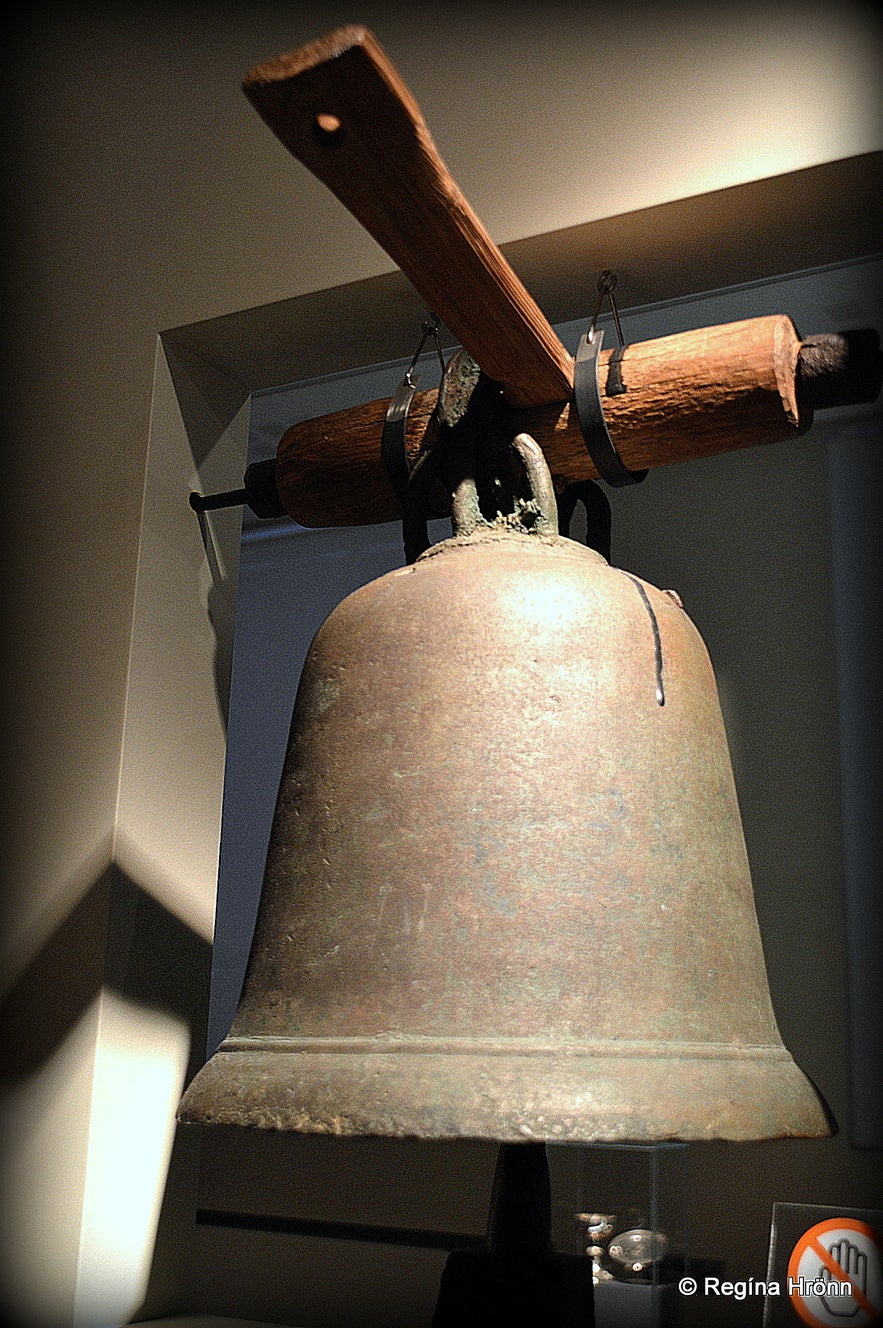
The ancient church bell from Hálskirkja church at the National Museum of Iceland dates back to 800-1150
So I show you what I found at the National Museum of Iceland instead. Several artefacts from Hálskirkja can be seen at the museum, amongst them this ancient church bell.
The church bell is of a beehive shape and dates back to the mid-12th century or 1200 at the latest. This bell is one of the oldest of its kind in the Northern world, so it is quite precious.
Another artefact from Hálskirkja can be found at the National Museum - a beautiful old carved chandelier, most likely dating back to the 17th century.

An old chandelier from Hálskirkja church on display at the National Museum of Iceland
I often tell you about Icelandic folklore in my travel blogs, but very few of them are ghost stories.
One such story happened here at Háls...
A ghost story from Háls

Fornhólar in the vicinity can be seen from the church.
An account from the 19th century in Íslenskar þjóðsögur - Icelandic Folklore by Ólafur Davíðsson - tells us about a ghost with murder in mind at the farm of Háls!
Ólafur Jónsson tells us that when he was staying for the night as a guest at the farm, he heard footsteps walking towards his bed and he was stabbed twice in the back!
His father had the same story to tell; he dreamt that he was stabbed in the back when he was staying for the night in that same room at the farm.
Apparently, a farmhand had cut his throat in the room where they were sleeping and it was believed that he was playing a trick on people. Other people had a similar story to tell; of either being attacked or being hit in the back.

The gate to Hálskirkja church
I usually don't add ghost stories in my travel-blog, as I am terrified of ghosts, I think it might be in our DNA and the long winter darkness in Iceland.
But if you are into Icelandic ghost stories then here is the most famous one, Djákninn á Myrká - the Deacon of Dark River, which also happened in North Iceland.
The Deacon of Dark River - Djákninn á Myrká - a Ghost Story from North Iceland
Draflastaðakirkja church in Fnjóskadalur
Draflastaðakirkja church
We now crossed ring-road 1 and turned on road 834 to visit the north side of Fnjóskadalur valley. There is the 3rd church in Fnjóskadalur, Draflastaðakirkja from 1926.
Unfortunately, it was also closed and nobody around to give us the key.
It is so sad that the churches have to be kept closed now due to vandalism, which makes it so difficult for a church enthusiast like me to visit these wonderful little gems, which are scattered all over Iceland.

A carved wooden chair from around 1500 from Draflastaðakirkja church - now at the National Museum of Iceland
The Fnjóská river then runs its course west through Dalsmynni and into Eyjafjörður, the longest fjord in Iceland.
We have a Saga from this area, Ljósvetningasaga, that tells us the story of the Chieftain Þorgeir Ljósvetningagoði, who decided at Þingvellir whether the nation should remain heathen or adopt Christianity.
Þorgeir opted for Christianity and the Icelandic nation has been Christian ever since the year 999 or 1.000.
Vaðlaheiðargöng tunnel
This is a photo I took from the Fnjóskadalur side when the tunnel was under construction.
Before I call it a day I want to show you what happened when the Vaðlaheiðargöng tunnel was being built. The work started in 2013 from Eyjafjörður fjord and was supposed to take 3 years, but unforeseen events took place - the earth was full of both hot and cold water, so the building of the tunnel took 5 years to complete!
First, they struck 46 degrees C hot water which started pouring out of the tunnel at a speed of 350 litres/second! This can happen when you live on a volcanic island, but was for sure not to be expected or else they would not have started building a tunnel in this place.
See also: A Local's favourite Volcanic Craters in Iceland

The upper waterfall
From across the Eyjafjörður fjord, it looked like a geyser had opened and the water poured from the tunnel and into the sea; creating some pretty hot waterfalls. In September 2015 we went to check it out and took a footbath in the hot water very close to the edge.
In my photo below you can see how I am sitting way too close to the edge, with a hot waterfall cascading into the sea of Eyjafjörður fjord right next to me. This cannot be done any longer, as it is on private land, but it was so nice while it lasted.
Skógarböðin hot baths opened in 2022, where they will make use of all of the 61 litres per second 49.7 degrees C hot and clean water.

I took a footbath in the hot water - it was heavenly
The work on the tunnel had started from the Eyjafjörður side of the mountain, and now they tried drilling on the Fnjóskadalur side of the mountain.
There the tunnel got filled with loose material and cold water flooded the tunnel; the work was halted for a month.
Despite these predicaments, they were finally able to open the tunnel to traffic on the 21st of December 2018.
So you can see that the construction of the Vaðlaðheiðargöng tunnel was quite a feat and we appreciate it even more after all the effort that was put into opening this much safer route across Vaðlaheiði heath.

Hot waterfalls in Eyjafjörður
The old road across the Vaðlaheiði heath reaches a maximum height of 520 metres with a lot of curves. That road used to be the main road and the route I remember from my childhood.
I last passed Vaðlaheiði heath back in 2015; we had to drive through the construction area of the tunnel to find the road and were scolded by the guard on site for trespassing :(
But, we were not trespassing but had to drive through the construction area to find the beginning of the old road across the heath.

The road sign by Fnjóskadalur
To visit this area you can rent a car in Reykjavík or Akureyri. The distance to Fnjóskadalur from Reykjavík is 404 km, and the distance to Akureyri is 16 km through the tunnel (where you must pay a toll).
Here we are in the vicinity of many of Iceland's pearls of nature, f.ex. the extraordinary Diamond Circle.
I have written a couple of travel-blogs about the Diamond Circle:
The Jewels of the North - the extraordinary Diamond Circle in North Iceland
The Spectacular Diamond Circle in North-Iceland
See also:
Aldeyjarfoss Waterfall in North Iceland in extraordinary Basalt Column Settings
The Picturesque Hrafnabjargafoss Waterfall in Skjálfandafljót River in North Iceland
The Historical Goðafoss Waterfall in Skjálfandafljót River
Have a lovely time in Fnjóskadalur valley and North Iceland :)
Sources:














